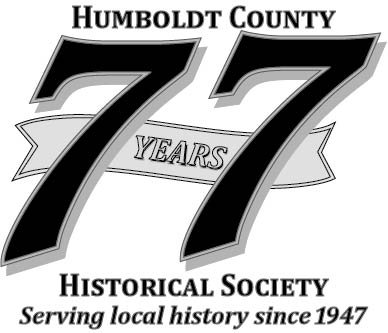Flooding Humboldt
When people feel that a newsworthy event is historic, they tend to save newspapers that report it. Nationally, that happened with newspaper front pages about President Kennedy’s assassination. In Humboldt County, that also happened with newspapers covering big floods – particularly the one in 1955 and the even larger one in 1964.
As a result, the Humboldt County Historical Society has a large archival collection about our major floods – not only newspapers, but photos, slides, scrapbooks, films, books and personal accounts.
The Eel and other area rivers had flooded several times in the 19th century and again in 1915 and 1937. The massive inundation that hit the area in the winter of 1955 was declared by experts to be the “1000-year flood”. It inundated farm lands and towns and completely wiped two communities off the map – Dyerville and Elinor.
It was partly this attribution, the belief that they had already experienced the worst flood in 1,000 years, that led many area residents to discount the initial forecast of dangerous flood conditions in late December 1964.
Early that month, a cold front dropped several feet of snow on the Sierras and other northern California mountains. Shortly after, a warm storm moved in from the south deluging the area with over 30 inches of rain in a week. Reportedly the rainfall was so intense that drivers had to pull over because even high-speed wipers were useless. This all coincided with the highest ocean tide of the year, meaning that the sudden snow melt and torrents of rainwater could not drain out to sea over the surging tides.
As river waters began rising, many residents were evacuated from along the Eel and its tributaries as well as the Klamath River basin. But not all the livestock in these rich farmlands were as fortunate. Many drowned, but one lucky cow, swept out to sea from the Eel, washed up alive at Crescent City a week later. Some household items even washed up in Japan later in the year.
Lumber mills and log ponds were overwhelmed. Vast quantities of logs were swept away and joined with uprooted trees to smash into buildings, bridges and roads. Communications and delivery of supplies were cut off as highways were inundated and sections of railways wiped out. Bridges like the Golden Bear bridge at Klamath were cut through. Only a massive effort with cranes relieved log jams enough to save historic Fernbridge.
Although land, air and telephone communication were initially cut, rescue efforts were soon underway. The Coast Guard, Army and local volunteers rescued flood stranded residents. Neighbors pitched in to provide food, clothing and shelter. Former roadways became airstrips as supplies were flown in. Among the many lives lost were seven rescuers killed in helicopter crashes.
In January of 1965, the floodwaters gradually receded, leaving silt covered farmlands, destroyed homes, and land strewn with dead livestock and unopened Christmas presents. Again, some smaller communities were completely wiped out.
Soon, rebuilding and reconnecting began. Briefly, this area received national media attention and dignitaries came in to view the damage or attend ceremonial re-openings.
Today, over half a century later, few recognizable signs of the great Christmas Flood remain – the major exception being the high-water markers along the highways showing the almost unbelievable height that the 1964 flood waters reached.
However, extensive records of these events also remain at the Humboldt County Historical Society and are open to anyone interested in learning more about this chilling subject.
In a time when extreme weather and climate have become a part of our present, such knowledge seems even more important.

